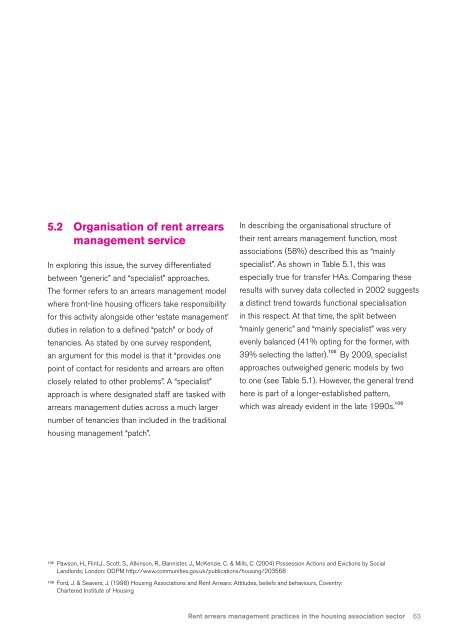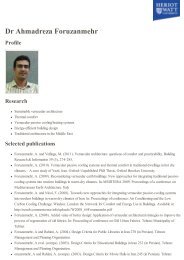Rent arrears management practices in the housing association sector
Rent arrears management practices in the housing association sector
Rent arrears management practices in the housing association sector
Create successful ePaper yourself
Turn your PDF publications into a flip-book with our unique Google optimized e-Paper software.
5.2 Organisation of rent <strong>arrears</strong><br />
<strong>management</strong> service<br />
In explor<strong>in</strong>g this issue, <strong>the</strong> survey differentiated<br />
between “generic” and “specialist” approaches .<br />
The former refers to an <strong>arrears</strong> <strong>management</strong> model<br />
where front-l<strong>in</strong>e hous<strong>in</strong>g officers take responsibility<br />
for this activity alongside o<strong>the</strong>r ‘estate <strong>management</strong>’<br />
duties <strong>in</strong> relation to a def<strong>in</strong>ed “patch” or body of<br />
tenancies . As stated by one survey respondent,<br />
an argument for this model is that it “provides one<br />
po<strong>in</strong>t of contact for residents and <strong>arrears</strong> are often<br />
closely related to o<strong>the</strong>r problems” . A “specialist”<br />
approach is where designated staff are tasked with<br />
<strong>arrears</strong> <strong>management</strong> duties across a much larger<br />
number of tenancies than <strong>in</strong>cluded <strong>in</strong> <strong>the</strong> traditional<br />
hous<strong>in</strong>g <strong>management</strong> “patch” .<br />
In describ<strong>in</strong>g <strong>the</strong> organisational structure of<br />
<strong>the</strong>ir rent <strong>arrears</strong> <strong>management</strong> function, most<br />
<strong>association</strong>s (58%) described this as “ma<strong>in</strong>ly<br />
specialist” . As shown <strong>in</strong> Table 5 .1, this was<br />
especially true for transfer HAs . Compar<strong>in</strong>g <strong>the</strong>se<br />
results with survey data collected <strong>in</strong> 2002 suggests<br />
a dist<strong>in</strong>ct trend towards functional specialisation<br />
<strong>in</strong> this respect . At that time, <strong>the</strong> split between<br />
“ma<strong>in</strong>ly generic” and “ma<strong>in</strong>ly specialist” was very<br />
evenly balanced (41% opt<strong>in</strong>g for <strong>the</strong> former, with<br />
39% select<strong>in</strong>g <strong>the</strong> latter) . 105 By 2009, specialist<br />
approaches outweighed generic models by two<br />
to one (see Table 5 .1) . However, <strong>the</strong> general trend<br />
here is part of a longer-established pattern,<br />
which was already evident <strong>in</strong> <strong>the</strong> late 1990s . 106<br />
105 Pawson, H ., Fl<strong>in</strong>t,J ., Scott, S ., Atk<strong>in</strong>son, R ., Bannister, J ., McKenzie, C . & Mills, C . (2004) Possession Actions and Evictions by Social<br />
Landlords; London: ODPM http://www .communities .gov .uk/publications/hous<strong>in</strong>g/203568<br />
106 Ford, J . & Seavers, J . (1998) Hous<strong>in</strong>g Associations and <strong>Rent</strong> Arrears: Attitudes, beliefs and behaviours, Coventry:<br />
Chartered Institute of Hous<strong>in</strong>g<br />
<strong>Rent</strong> <strong>arrears</strong> <strong>management</strong> <strong>practices</strong> <strong>in</strong> <strong>the</strong> hous<strong>in</strong>g <strong>association</strong> <strong>sector</strong> 63




